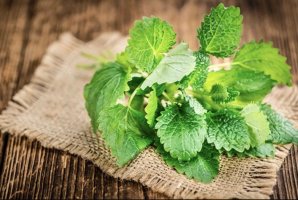Lemon Balm (Melissa Officinalis)

Lemon balm is an amazingly aromatic plant, with a scent of sweet lemon. It has both culinairy and medicinal purposes, making it a top plant to grow in your garden.
Lemon balm has been used as far back as the middle ages for many purposes, which will be listed in this article.
Growing lemon balm
Lemon balm is a hardy perennial shrub that can be grown year-round outside in warmer climates, though it does well indoors in colder climates. It grows well both in the ground and in containers. Being native to europe, it is now grown all around the world.
It prefers nutrient rich, moist soil. Whilst it prefers full sun, in hot climates on Summer days the leaves might yellow. For best potency, harvest the leaves before it flowers. Be wary, in some climates the seeds can become invasive if left unchecked.
It also allows for easy cuttings, making multiplying this plant very easy. Take a cutting and stick it in a glass of water or in very wet soil and ensure it stays moist for at least 2 weeks for optimal results. Do not panic if the leaves completely start drooping and look wilted. Lemon balm is very sassy and will likely appear droopy within the first minute of harvesting. So long as the soil stays mois (or the stem is kept in water) it usually recovers by the next day and will start rooting soon.
Health benefits
Lemon balm is best paired with other remedies. Lemon balm oil is said to also have antibacterial properties.
In the middle ages it has been used to ease pain and discomfort from indigestion, improve appetite, reduce stress and anxiety, and promote good sleep. Nowadays it is often combined with other calming, soothing herbs, like chamomile, valerian and hops. This promotes their relaxing effects.
Sometimes lemon balm is even found in topical ointments to treat cold sores and lesions, often helping reduce the healing time.
Uses
Lemon balm can be used in many ways. In culinary recipes it often helps bring food to the next level, by providing a slight lemony and fresh tang to food. Generally it would be used just like any other fresh herb, often working well in place of mint. It can be eaten both cooked and raw.
Lemon balm can be steeped into a tea, both dried and fresh. It's said to be just as soothing as chamomile, but with a lovely citrusy flavour.
You can chew on lemon balm leaves to freshen your breath.
Crushed it can be used to treat bug bites, in order to ease the itch.
In aromatherapy it is often considered to be uplifting and calming.
You could turn them into an oil, which can be used in many ways. It can be used in skincare, cooking and aromatherapy.
Potential dangers
Like anything, it can come with a risk. They can include, but are not limited to, rashes, diarrhoea, nausea, wheezing. It can also interact badly with medicine like sedatives. Use a reasonable sense of caution and if something doesn't feel right, stop using it.
